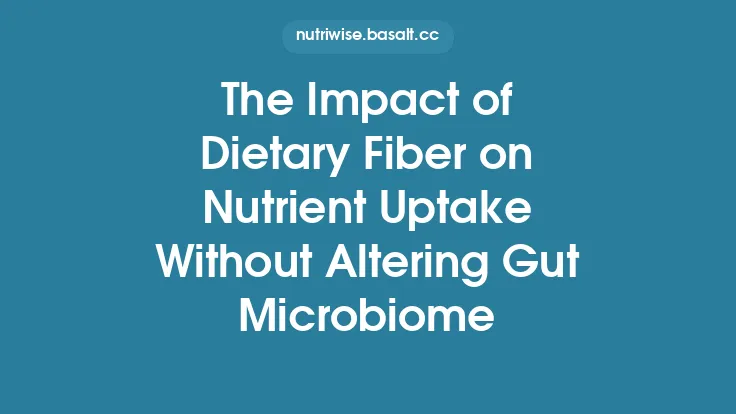Dietary fiber, long recognized for its benefits to gastrointestinal health, also plays a nuanced and sometimes paradoxical role in the absorption of essential minerals such as calcium, iron, magnesium, zinc, and copper. Unlike isolated nutrients, fiber exerts its influence through a combination of physical, chemical, and microbiota‑mediated mechanisms that together shape the luminal environment, alter mineral solubility, and modulate the activity of intestinal transport proteins. Understanding these mechanisms is crucial for nutrition scientists, clinicians, and dietitians who aim to optimize mineral status while preserving the well‑documented advantages of a high‑fiber diet.
Types of Dietary Fiber and Their Physicochemical Properties
Dietary fiber is a heterogeneous group of plant‑derived carbohydrates that resist digestion by human brush‑border enzymes. It is broadly classified into two categories based on solubility and fermentability:
| Fiber Type | Solubility | Viscosity | Fermentability | Representative Sources |
|---|---|---|---|---|
| Soluble, viscous fibers | Soluble | High (e.g., β‑glucan, pectin, guar gum) | Highly fermentable | Oats, barley, legumes, citrus peel |
| Insoluble fibers | Insoluble | Low (e.g., cellulose, hemicellulose, lignin) | Variable, often partially fermentable | Whole‑grain wheat bran, nuts, seeds |
| Resistant starches | Variable (often considered a separate class) | Low to moderate | Highly fermentable | Cooked‑and‑cooled potatoes, green bananas, legumes |
| Fermentable oligosaccharides | Soluble | Low | Highly fermentable | Fructooligosaccharides (FOS), galactooligosaccharides (GOS) |
The physicochemical attributes of each fiber type dictate how it interacts with minerals:
- Viscosity creates a gel‑like matrix that can trap minerals, slowing their diffusion toward the absorptive surface.
- Water‑holding capacity influences the dilution of luminal electrolytes, potentially reducing ionic strength and altering mineral solubility.
- Particle size and surface area affect the extent of mineral adsorption onto fiber matrices.
- Fermentability determines the production of short‑chain fatty acids (SCFAs) and the consequent changes in luminal pH, both of which are pivotal for mineral solubility and transporter activity.
Fermentation of Fiber and Production of Short‑Chain Fatty Acids
When fermentable fibers reach the colon, resident microbiota metabolize them into SCFAs—primarily acetate, propionate, and butyrate—in roughly a 60:20:20 molar ratio, though this can vary with substrate type and microbial composition. SCFAs influence mineral uptake through several interrelated pathways:
- pH Modulation
SCFA production lowers colonic pH (often to 5.5–6.5). A more acidic environment increases the solubility of divalent cations such as calcium and magnesium by reducing the formation of insoluble hydroxides and carbonate complexes. For iron, a lower pH favors the conversion of ferric (Fe³⁺) to the more soluble ferrous (Fe²⁺) form, enhancing its availability for uptake.
- Enhanced Paracellular Transport
SCFAs, particularly butyrate, stimulate the expression of tight‑junction proteins (e.g., claudin‑2) that transiently increase paracellular permeability. This creates additional pathways for passive diffusion of small, soluble mineral ions, especially calcium.
- Stimulation of Active Transporters
Propionate and butyrate have been shown to up‑regulate the expression of calcium‑transporting proteins such as TRPV6 (transient receptor potential vanilloid 6) and the sodium‑dependent phosphate transporter NaPi‑IIb, indirectly supporting calcium and phosphate absorption.
- Energy Supply for Enterocytes
SCFAs serve as an energy substrate for colonocytes, maintaining epithelial health and turnover. A robust epithelium is essential for the proper functioning of active mineral transport mechanisms.
Modulation of Luminal pH and Mineral Solubility
Beyond SCFA‑driven acidification, fiber can affect luminal pH through its buffering capacity. Certain fibers, especially those rich in fermentable oligosaccharides, contain residual organic acids (e.g., lactic acid) that contribute to a mildly acidic milieu even before fermentation begins. This pre‑emptive pH shift can:
- Prevent precipitation of calcium as calcium oxalate or calcium phosphate, thereby preserving its soluble fraction.
- Maintain iron in the ferrous state, which is less prone to forming insoluble complexes with dietary inhibitors such as polyphenols.
- Facilitate magnesium solubilization, as magnesium hydroxide precipitates at higher pH values.
The net effect is a more favorable chemical environment for mineral dissolution, which is a prerequisite for both passive diffusion and transporter‑mediated uptake.
Impact on Mineral Transporters and Cellular Uptake Mechanisms
Mineral absorption in the small intestine involves a coordinated set of transport proteins, channels, and binding proteins. Dietary fiber can influence these components through both direct and indirect mechanisms:
- Regulation of Calcium Transport
- TRPV6 and Calbindin‑D9k – Soluble fibers that increase luminal calcium concentration can up‑regulate the expression of the calcium channel TRPV6 and the intracellular calcium‑binding protein calbindin‑D9k, enhancing transcellular calcium transport.
- Vitamin D‑Independent Pathways – Certain fermentable fibers stimulate calcium absorption even in the absence of active vitamin D, suggesting alternative signaling pathways (e.g., SCFA‑mediated G‑protein coupled receptor activation).
- Iron Uptake
- DMT1 (Divalent Metal Transporter‑1) – Acidic luminal conditions generated by fiber fermentation increase Fe²⁺ availability, which is the substrate for DMT1 on the apical membrane of enterocytes.
- Ferroportin Regulation – SCFAs may modulate hepcidin expression indirectly, influencing ferroportin‑mediated basolateral export of iron.
- Magnesium and Zinc Transport
- TRPM6/7 (Transient Receptor Potential Melastatin 6/7) – These channels mediate magnesium uptake; fiber‑induced changes in luminal ionic strength can affect channel kinetics.
- ZIP and ZnT Families – For zinc, soluble fibers that lower pH can increase Zn²⁺ solubility, facilitating uptake via ZIP (Zrt‑ and Irt‑like Protein) importers, while the expression of ZnT (zinc transporter) exporters may be modulated by SCFA signaling.
Overall, fiber does not act as a simple inhibitor or enhancer; rather, it fine‑tunes transporter expression and activity in response to the dynamic luminal environment it helps create.
Interactions with the Mucus Layer and Epithelial Barrier
The intestinal mucus layer, composed primarily of mucin glycoproteins, serves as the first physical barrier that luminal contents encounter before reaching the epithelium. Dietary fiber influences this barrier in several ways:
- Mucus Production – Fermentable fibers stimulate goblet cell activity, leading to increased mucin secretion. A thicker mucus layer can sequester minerals, potentially reducing their immediate availability but also protecting the epithelium from abrasive particles and pathogens.
- Viscous Gel Formation – Soluble, high‑viscosity fibers can embed within the mucus, creating a diffusion barrier that slows mineral transit. While this may modestly reduce rapid absorption, it also prolongs the contact time between minerals and the absorptive surface, which can be beneficial for low‑affinity transport processes.
- Mucosal Binding Sites – Certain fiber fragments possess carboxyl or phenolic groups capable of weakly chelating cations. This reversible binding can act as a “reservoir,” releasing minerals gradually as the pH or ionic conditions shift.
The net impact of these interactions is context‑dependent, varying with fiber type, intake level, and the specific mineral in question.
Role of Gut Microbiota in Fiber‑Mineral Interplay
The composition and metabolic capacity of the gut microbiome are central to how fiber modulates mineral uptake:
- Microbial Enzymes and Mineral Release
Some bacteria produce phytase‑like enzymes that liberate bound minerals from complex plant matrices. Although phytates themselves are covered elsewhere, the broader concept of microbial de‑complexation applies to other fiber‑associated mineral complexes.
- Biofilm Formation
Certain commensal species form biofilms on the mucosal surface that can trap minerals. The biofilm matrix, rich in extracellular polymeric substances, may either sequester minerals (reducing absorption) or act as a conduit for gradual release.
- Cross‑Feeding Networks
Primary fermenters (e.g., Bifidobacterium) generate lactate and acetate, which are then utilized by secondary fermenters (e.g., Faecalibacterium prausnitzii) to produce butyrate. This cascade amplifies SCFA production, reinforcing the pH‑dependent mechanisms described earlier.
- Microbial Regulation of Host Gene Expression
Metabolites derived from fiber fermentation can act as signaling molecules (e.g., via G‑protein coupled receptors GPR41/43) that influence host gene transcription, including that of mineral transporters and tight‑junction proteins.
Thus, the microbiota serves as an intermediary that translates the chemical properties of dietary fiber into biologically relevant signals affecting mineral homeostasis.
Clinical Implications and Dietary Recommendations
Given the dualistic nature of fiber’s impact on mineral absorption, practical guidance must balance the benefits of high fiber intake with the need to maintain adequate mineral status:
- Timing of Fiber and Mineral Intake
- Separate Meals – Consuming high‑fiber foods at a different time than mineral‑rich meals (e.g., 1–2 hours apart) can minimize transient competition for absorption sites, especially for iron.
- Co‑Consumption with Vitamin D – For calcium, pairing fiber‑rich foods with vitamin D–rich foods or supplements can enhance active calcium transport, offsetting any potential reduction in passive diffusion.
- Choice of Fiber Type
- Soluble, Fermentable Fibers – These are generally more favorable for enhancing mineral solubility via SCFA production. Examples include oats, barley, and certain legumes.
- Insoluble Fibers – While beneficial for bowel regularity, excessive intake of highly insoluble fibers (e.g., large amounts of wheat bran) may physically entrap minerals and modestly reduce absorption.
- Adequate Fluid Intake
Sufficient water consumption helps maintain optimal viscosity and prevents excessive gel formation that could impede mineral diffusion.
- Population‑Specific Considerations
- Children and Adolescents – Rapid growth demands high calcium and iron; moderate fiber intake with attention to timing is advisable.
- Postmenopausal Women – Increased risk of osteoporosis makes calcium bioavailability critical; incorporating fermentable fibers alongside calcium‑rich foods can be advantageous.
- Individuals with Malabsorption Syndromes – Tailored fiber regimens, possibly emphasizing low‑viscosity soluble fibers, may help improve mineral uptake without exacerbating diarrheal symptoms.
Future Research Directions and Emerging Technologies
While substantial progress has been made, several knowledge gaps remain:
- Molecular Mapping of Fiber‑Mineral Interactions – Advanced spectroscopic techniques (e.g., solid‑state NMR, X‑ray absorption spectroscopy) can elucidate the precise binding sites and affinities between specific fiber polymers and mineral ions.
- Omics‑Driven Microbiome Studies – Metagenomics combined with metabolomics will clarify which microbial taxa and metabolic pathways most effectively convert fiber into SCFAs that favor mineral absorption.
- Personalized Nutrition Platforms – Machine‑learning models that integrate individual microbiome profiles, dietary patterns, and genetic polymorphisms (e.g., in calcium‑transport genes) could predict optimal fiber‑mineral pairings.
- Novel Fiber Formulations – Engineered prebiotic fibers with tailored fermentability and viscosity profiles may be designed to maximize beneficial SCFA production while minimizing mineral sequestration.
- In‑Vivo Imaging of Mineral Transport – Emerging imaging modalities such as synchrotron‑based X‑ray fluorescence microscopy can visualize real‑time mineral movement across the intestinal epithelium in animal models, providing direct evidence of fiber‑mediated effects.
Continued interdisciplinary research—bridging food chemistry, microbiology, physiology, and data science—will refine our understanding of how dietary fiber can be strategically employed to support optimal mineral nutrition throughout the lifespan.





